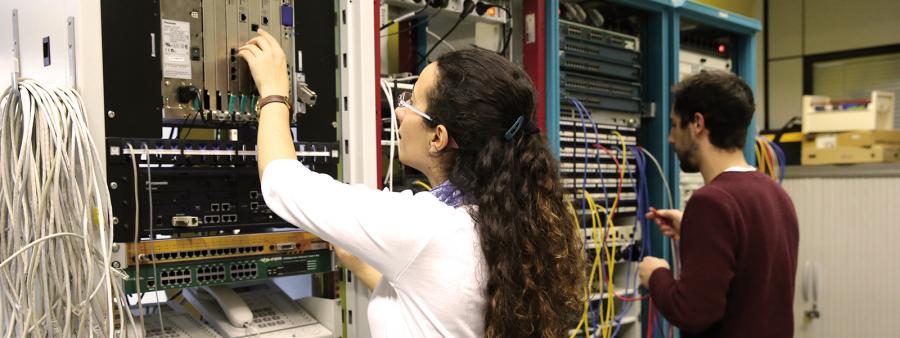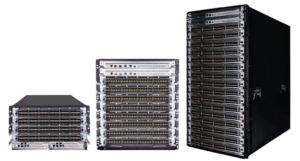HP Network Equipment

Hi folks. On today's post we'll analize the different network hardware we're going to be using to build the case's datacenter in a 2-tier topology. Since budget is not an issue and the state of the art hardware is wanted we'll go for the big beasts of the house. Its important to take into consideration that since we're going for a modern data center implementation we're gonna build logically on top of Virtualization, NFV & SDN concepts so we'll need plain equipment that helps us interconnect all the bare metal and achieve scalability, redundancy, failure segmentation, redundancy and high availability in our physical infrastructure. We'll more concretely be analizing the HPE 12900E Switch Series for the core/aggregation layer and the HPE FlexFabric 5950 Switch Series for the access layer. HPE FlexFabric 12900E Switch Series (core/aggregation layer) The HPE FlexFabric 12900E is HPE’s major core data center switching platform for next generation software defined data centers. It delivers unprecedented levels of performance, buffering, scale and availability with high density 10GbE, 40GbE and 100GbE interfaces which are requirements for the bank's datacenter. The switch series includes a 4-, 8-, and 16-slot chassis, and it supports full Layer 2 and 3 features and advanced data center features. This capabilities allow us to implement the desired L2 inside L3 topology and achieve the speeds we required. Other relevant specifications of the Switch Series are the following:
- Non-blocking, lossless Clos architecture with VOQs and large buffers with the flexibility and scalability for future growth.
- Distributed architecture delivers enhanced fault tolerance and facilitates continuous operation and zero service disruption during planned or unplanned control-plane events.
- Up to 46 Tbps switching capacity and 28.8 Bpps, providing you non-blocking wire speed performance more than enough to handle the whole datacenter's traffic.
- High-density 1GbE, 10GbE, 40GbE and 100GbE interface connectivity. From which we'd be mostly interested on the higher options.
- Ability to build Layer 2 fabrics which are flexible, resilient, and scalable with VxLAN, TRILL and/or Hewlett Packard Enterprise IRF. Then having all the technologies denoted on previous posts as of high importance for the data center network design.
- Multitenant Device Context (MDC) for multi-tenancy giving you the ability to virtualize a physical switch into multiple logical devices; each logical switch has its own tenants.
 This kind of device would be an equivalent to the Cisco Nexus delivering a ton of horsepower to serve as a core switch of the datacenter. HPE FlexFabric 5950 Switch Series The HPE FlexFabric 5950 is a 25/50/100GbE networking switch series that provides customers with a high density and ultra-low latency solution enabling them to deploy network configurations for business critical applications. Consisting of a 1U 32-port 100GbE QSFP28 Switch, the 5950 brings high density to a small footprint. The 100GbE ports may be split into four 25GbE ports and can also support 40GbE which can be split into four by 10GbE for a total of 128 25/10GbE ports. The most important aspect of this switch is the ultra low latency and ultra high speeds it can deliver in its ports since in a banking environment those are pretty important things. Also the modern data center capabilities it provides, with its fine manipulation of data, make for a very powerful combination for rapidly and dynamically adapting the network to the moment's requirements. Other relevant characteristics of this series are the following:
This kind of device would be an equivalent to the Cisco Nexus delivering a ton of horsepower to serve as a core switch of the datacenter. HPE FlexFabric 5950 Switch Series The HPE FlexFabric 5950 is a 25/50/100GbE networking switch series that provides customers with a high density and ultra-low latency solution enabling them to deploy network configurations for business critical applications. Consisting of a 1U 32-port 100GbE QSFP28 Switch, the 5950 brings high density to a small footprint. The 100GbE ports may be split into four 25GbE ports and can also support 40GbE which can be split into four by 10GbE for a total of 128 25/10GbE ports. The most important aspect of this switch is the ultra low latency and ultra high speeds it can deliver in its ports since in a banking environment those are pretty important things. Also the modern data center capabilities it provides, with its fine manipulation of data, make for a very powerful combination for rapidly and dynamically adapting the network to the moment's requirements. Other relevant characteristics of this series are the following:
- 3.2 Tbps switching capacity for the most demanding applications.
- 2976 MPPS throughput for data-intensive environments.
- Under a 1µs 100GbE latency.
- VXLAN support for network virtualization and overlay solutions. – OVSDB for dynamic VXLAN tunnel management
- IRF < 50 msec convergence time enabling faster application response time
- IRF-based In Service Software Update (ISSU) enables high availability with updates accomplished without a reboot or power cycle, in the background
- Software-defined Network (SDN) capabilities
 Although there is not a direct equivalent the equivalent series for access switches on the Cisco datacenter portfolio would be the Cisco Catalyst 6500 Series. With the devices that are going to be used already exposed, just remember to check the other post of the week to take a look at how these devices are going to be used to build the data center's topology. Until next week!!
Although there is not a direct equivalent the equivalent series for access switches on the Cisco datacenter portfolio would be the Cisco Catalyst 6500 Series. With the devices that are going to be used already exposed, just remember to check the other post of the week to take a look at how these devices are going to be used to build the data center's topology. Until next week!!
Add new comment